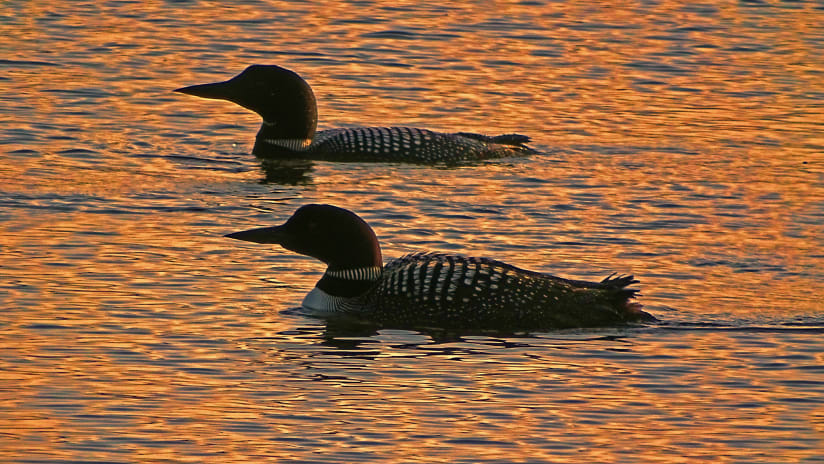You’ve seen it on the crest and if you’ve been to a match at TCF Bank Stadium or watched one on TV, you’ve probably heard the supporters chanting, “COME ON YOU LOONS,” but how much do you really know about Gavia immer, the common loon? If you’re a Minnesotan, you probably know it’s the state bird (since 1961) and chances are good you’ve heard their familiar call on a northern lake at some point.
But there’s a lot more to the common loon than that. For example, males and females have similar plumage and — of course — deep red eyes. The “immer” part of their Latin name comes from the Norwegian name for the bird, which either comes from the Swedish word “immer” or “emmer” for blackened ashes or the Latin “immersus” for “submerged.” And while they’re expert divers (which is actually what they’re called in Europe instead of “loons”), they’re clumsy on land because their feet are too far back on their bodies to walk well. As a result, they build their nests close to the water and haul themselves up and scoot around with a combination of muscles in their abdomens and chests.
That’s all fairly common knowledge, though. Lori Naumann — a non-game specialist with the Department of Natural Resources — had some things to share that we’ve only recently learned about loons thanks to the work of Minnesota’s Non-Game Wildlife Program and the United States Geological Survey.
While many sites say they can dive to depths of up to 90 feet, recent telemetry studies have shown that loons — who can live in both fresh and salt water thanks to the unique composition of their feathers — regularly dive as deep as 200 feet in the Gulf of Mexico when they make their winter migration there.
“The other cool thing that we found out,” said Naumann, “is that loons from Minnesota, Wisconsin and Michigan, when they leave their natal lakes — the lake they were born or where they’re nesting — around the first week in October, they all go to Lake Michigan and hang out there for about a month before they go down to the Gulf of Mexico. They hang out and they’re eating goby, which are actually an invasive species, and these other small fish that are also high in fat content. And they get real fattened up until they make the migration south to the Gulf.
“But here’s the fascinating part,” she continued. “They leave their chicks on their natal lakes. The adults all get up and they leave, and they all go and party on Lake Michigan, and the chicks are still on their natal lakes for another month by themselves. And they get up for the first time in November and fly to the gulf all by themselves without ever having been there before. It still floors me that they’re able to do that when they just learned how to fly.” (You can follow individual loons' migrations with this nifty USGS site here.)
Don’t feel too bad for the chicks, though. When the adults decide it’s time to head back north, the young loons stay and party in the Gulf for two and a half years until they make their first return to the lakes where they were born.
And when they make that return, they’ll be looking for homes of their own. Although it’s a misconception that there will only be one breeding pair per lake — there can be multiple pairs depending on the size of the lake and the quality of the food available — loons are quite territorial and have a unique way of sussing out what they can and can’t take over.
“There’s a researcher in Maine who has been doing localization studies on loons for years,” said Naumann. “He learned that when an adult loon is flying over a lake and hears another loon on the lake, and they’re calling back and forth to each other, the one that’s flying can tell, from the sound of his voice, if he can take that bird on the lake. So he’ll come down and he’ll fight if it’s a good, coveted territory. Sometimes they stab each other in the chest to kill each other.”
Naumann points out that the posture of the loon on Minnesota United’s badge is the bird’s fighting stance and that they can be extremely vicious.
“I’ll tell you: I’ve been stabbed, I’ve been bitten,” said Naumann. “When we’re capturing those loons at night, the first thing you do is grab their neck, and hold their head away from you so that you don’t get stabbed. A loon came after [one of our researchers], and kind of stabbed him before he had a chance to grab it, and it punctured a hole through the band on his baseball cap, and punctured a hole in his head. They can be really nasty birds.”
That’s right: those beautiful, steadfast birds navigating the waters of northern Minnesota and issuing their ghostly calls into the night can turn into some cold-blooded killers when they’re pressed or threatened. Not a bad mascot for an upstart team, all things considered.
“My daughter’s terrified of them and she will not swim in a lake where there are loons,” said Naumann earnestly. “And she’s 28. She always says: ‘It’s those eyes. Those red eyes.’”




